Dee Estuary Birding
Monthly Newsletter...
September 2022 Newsletter
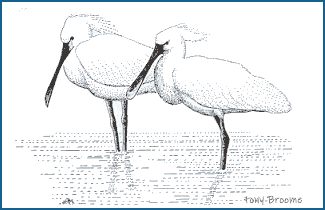
Wetland Bird Survey 2020/21

Covid had a big impact on the Wetland Bird Survey in
2020/21 with no counts taking place in July (2020) and limited coverage
from
January to March 2021. Such has been this impact that the BTO have
decided not to publish a 2020/21 Report, in particular too many counts
were missed at major complex sites to be able to use the data in any
meaningful manner. However, as far as the Dee Estuary is concerned
there has been a local report issued and, as the important late summer
to mid-winter period was fully covered we can at least look at the
numbers and discuss trends and any interesting counts. In addition
there was a low-tide WeBS performed in 2020/21 - this was fully counted
in November and December with about half the sectors counted in January
and February - so again we can discuss the counts which were carried
out (Note that low-tide WeBS counts are normally carried out only every
seven years - they are a lot of work and take a lot of organising!). I
should add that any analyses performed in this article are meant
as just brief summaries and any discussion about the data is my own
inexpert interpretation and opinion. Please contact the BTO for further
details and information.
My summary consists of discussing counts made for the following five species:
Great Egret
In 2015 I was speculating, with some amazement, that
it was possible that we could get Great Egrets in double figures
sometime in the next few years. Well, that figure was obtained the very
next year with 12 in 2016 and numbers have been going up ever since. In
the 2019/20 WeBS we had a record breaking 29 making the Dee Estuary the
second most important site in the country for this species, and in
2020/21 we had another record count of 44 in October. The max roost
count was 39 at RSPB Burton Mere Wetlands in September 2020 and three
pairs bred there producing 10 young in the spring of 2021. This is the
most northerly breeding site in the UK.
With their habit of feeding out of sight in gutters it is no surprise
that the Low-tide WeBS vastly under estimates the numbers but six were
on Parkgate Marsh for both the November and December counts, with the
same number on Burton Marsh in December.
Nationally, the Somerset Levels is the most important site and they had
a count of 62 in March 2020 and in 2021 they had 25 successful nests
producing 50 fledglings.
Wigeon
I don't know what it is about the Ribble Estuary
which is so attractive to Wigeon but they have enormous numbers there
with a few counts even exceeding 100,000, the last one being 101,594 in
November 2008. What an amazing sight that must have been. Here on the
Dee Estuary things are rather different, not only have we never had
numbers anything like that we haven't even ever had a five-figure
count!
But despite talk of birds staying on the east coast or short-stopping
on the continent the last five winters has seen five of the highest
WeBS counts ever recorded on the Dee Estuary. This includes the highest
count of 8,941 in November 2018 and the third highest in November 2020
with 8,048. Meanwhile the five-year average has been the highest it's
ever been now for the past four years and is currently at 7,600.
These large flocks can be difficult to see as Wigeon tend to stay well
into the upper reaches of the estuary. From the English side they are
often invisible off the outer edge of the marshes only being seen on a
big spring tide from Parkgate. The best site for them is undoubtedly
Connah's Quay Nature Reserve where they can be seen in the River Dee
channel and 2,500 where counted here during a Low-tide WeBS count in
December 2020.
Oystercatcher
November 10th 2020, I was down at my favourite patch
to do a Low-tide WeBS count. I was early so I did what I always do and
first stood on top of the cliff at Thurstaston and scanned the estuary
through my telescope. The tide was just beginning to ebb from my
sector, number 61, and was astonished at the numbers of waders. The
first to arrive were Dunlin piling in from West Kirby as soon as the
first bit of mud was showing, followed by Oystercatchers seemingly
coming from every direction. The Knot had been roosting next to Heswall
Marsh that morning and they were the last to arrive in one huge flock -
but more of those below.
If you stand by Dee Sailing Club with the causeway below you, sector 61
is the large mud bank the other side of the channel, beyond the moored
boats. In other words the north end of Dawpool Bank. It's always been
very attractive to waders but these last two winters have seen
exceptional numbers.
Two hours before low tide it was time to start my count. By this time
not only were large numbers of Oystercatchers feeding on the cockles a
lot must have already had their fill and there were several large
groups of them roosting. My average of three counts was 16,900. So that
meant just over 60% of the total number (30,636) of Oystercatchers
present on the Dee Estuary in November was in that one sector, my
sector!
The November total was high but by December even more were counted. The
birds were a lot more dispersed and I had less in sector 61 with 'just'
10,700. Elsewhere, there were 6,900 on Mostyn Bank (just south of Point
of Ayr), and 5,000 at both West Hoyle Bank and on the sand west of the
Hilbre islands and Tansky Rocks, with the rest scattered around the
estuary. The total low-tide count was very high with 41,871, higher
than any high tide count anywhere in the country since 2012!
The December 2020 high tide WeBS count for the Dee Estuary was a high
one at 28,319, the second highest winter count since 1993 - but it was
still a lot lower than that low tide count, the difference being
13,552. Strangely, the last low-tide WeBS count in 2014/15 had resulted
in almost exactly the same discrepancy with a high tide count of 26,152
and a low tide count of 39,306 - the difference being almost identical
to 2020/21 with 13,155. A hell of a coincidence!
I don't think anyone knows why there has been this difference between
the high and low tide counts but reasons could include: birds flying
inland to feed in fields at high tide not being counted, birds leaving
the estuary to roost elsewhere at high tide, one or more high tide
roosts on the estuary has been missed and not counted (but not very
likely), there is some inherit bias between counting tightly packed
flocks at high tide (perhaps under estimated) compared to the more
scattered feeding flocks at low tide (perhaps over estimated), there
can be as much as two weeks between when the low and high tide counts
take place so during that time birds could have flown into or out of
the estuary coming from, or moving to other major sites such as
Morecambe Bay. The truth may be a combination of all those.
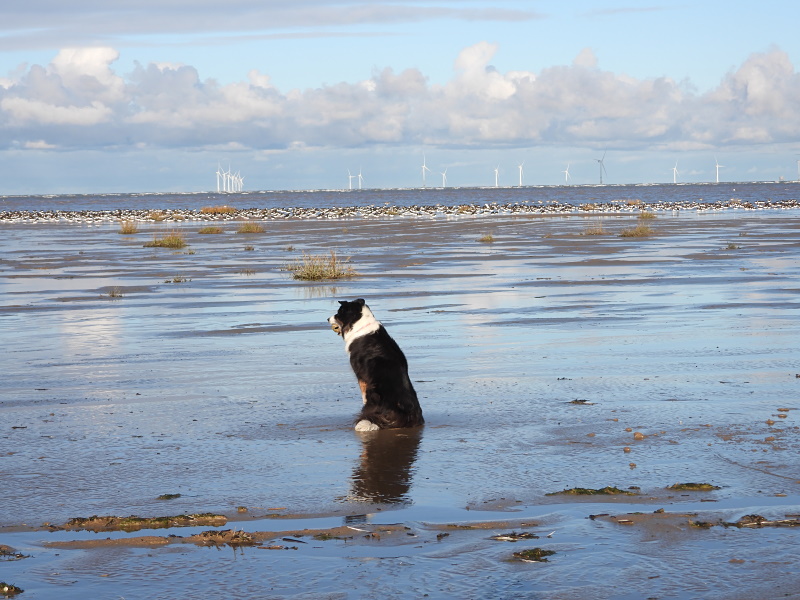
If only all dogs and their owners were so well behaved!!
Knot
Knot numbers can fluctuate on the Dee estuary hour
by hour let alone month by month or year by year and it is well known
that on some high tides (usually spring tides) many leave the estuary
to roost at Seaforth or further north along the Sefton Coast, perhaps
flying as far as Ainsdale. So a discrepancy between low and high tide
counts was expected and this is certainly what we saw.
As we knew the importance of Dawpool Bank for Knots my colleague Steve
Hinde and I coordinated our low tide WeBS counts in 2020 with my sector
61 and Steve's sector 62 (so covering all of Dawpool Bank). In November
we got a total of 28,200, over 80% of the total counted for the
estuary. Even more were present on the Estuary in December but our
combined Dawpool Bank count was still 28,000, but with the total for
the whole estuary a massive
52,606 - one of the highest ever counts on the Dee. Other high counts
included 10,000 on Mostyn Bank. Compare that with the Dee Estuary high
tide WeBS
count for November which was 10,224 and for December which was 13,832.
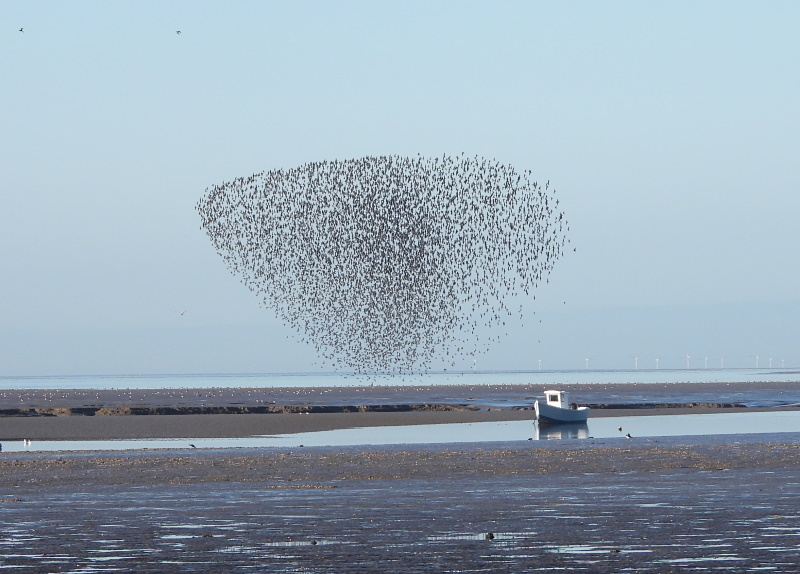
Bar-tailed Godwit
In the late 1960s and through the 1970s we used to get thousands of Bar-tailed Godwits on the Dee Estuary/North Wirral both feeding at low tide and roosting at high tide - numbers typically ranging from 5,000 to 10,000. But, presumably due to excess disturbance, in the winter of 1980/81 they suddenly deserted their high tide roosts (mostly West Kirby and Hoylake) and started using Formby and Crosby shore instead. They did continue to fly over to feed along North Wirral, in particular Leasowe Bay, in their thousands and I remember doing counts in the 2000's which were typically around the 5,000 mark but sometimes significantly higher. More recently numbers have plummeted and it's an exceptional count if we can get a few hundred even though much higher numbers are still seen over at Formby and in the Ribble Estuary.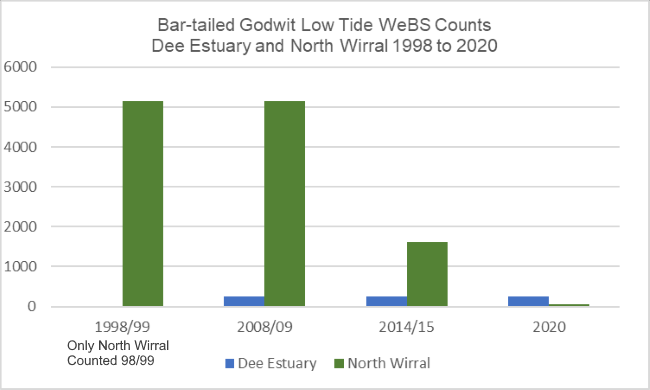
The bar chart shows numbers on North Wirral Shore (green bars) and, separately, numbers in the Dee Estuary (blue bars). The majority of Bar-tailed Godwits within the Dee Estuary itself are found at low tide off Thurstaston with typical counts usually between 100 to 300. Thurstaston is the only site locally where you regularly get Bar-tailed and Black-tailed Godwits feeding together and numbers there don't seem to have changed significantly over the past 30 years or so - unlike North Wirral.

Orange flag MC ringed at Altcar (Formby)
The photo, below, of Leasowe Shore in November 2010
brings back bad memories
for me. I don't know how the waders felt but I was traumatized! I
happened to go down there hoping to see some colour ringed Knot
completely unaware that I had picked the first day the area had been
opened up for industrial scale cockling. Tractors, 4 x 4s and Quad
bikes raced past me as I stood there bemused looking at the handful of
knot remaining although these soon left. So basically that stretch of
shore, about 4kms long, was denied to the many thousands of waders all
that winter. At that time it was one of the most important feeding
areas for waders not just in our area, but the whole country. I'll list
the protection it has - Special Protection Area and Special Area of
Conservation (then under the EU Habitats Directive and currently the
same under UK Law), a Ramsar site under International Treaty and a Site
of Special Scientific Interest (UK law). You couldn't get a more
protected site yet the fisheries industry is allowed to completely
ignore every one one of those laws as though they didn't exist. North
Wirral isn't the only area they have damaged as both the Wash and the
Waddensea have suffered very badly by industrial scale cockling in the
recent past.
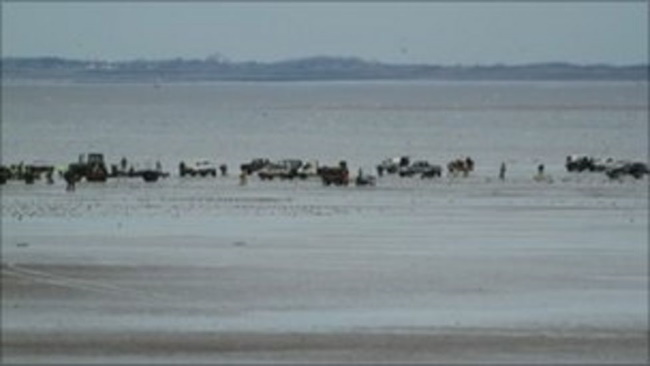
As far as I can see from counts made since the winter of 2010/11 wader
numbers, particularly Bar-tailed Godwits, have never recovered from
this and the bar chart above clearly shows this. Cockling isn't the
only problem, however, and increased activity by dog walkers, bait
diggers and para motors certainly haven't helped.
The counts along North Wirral for the 2020 Low Tide
WeBS counts were particularly dire with just 19 Bar-tailed Godwits, 231
Knots, 226 Dunlins and 203 Oystercatchers. There is some good news,
however, as this last winter (2021/22) saw much better numbers.
Although there was a maximum of only 372 Bar-tailed Godwits the other
three species mentioned were all substantially higher including a count
of 9,445 Oystercatchers in January which is a very high count for North
Wirral. Lets hope this trend continues.
References:
1. Neil Friswell and Colin Wells, Dee Estuary and North Wirral Foreshore WeBS Annual Report 2020/2021.
2. WeBS Report Online (https://app.bto.org/webs-reporting/numbers.jsp),
BTO.
3. Richard Smith, WeBs and Waders, Dee Estuary
Newsletter May 2007, http://www.deeestuary.co.uk/news0507.htm.
Richard Smith
Colour Ring Report
Turnstone
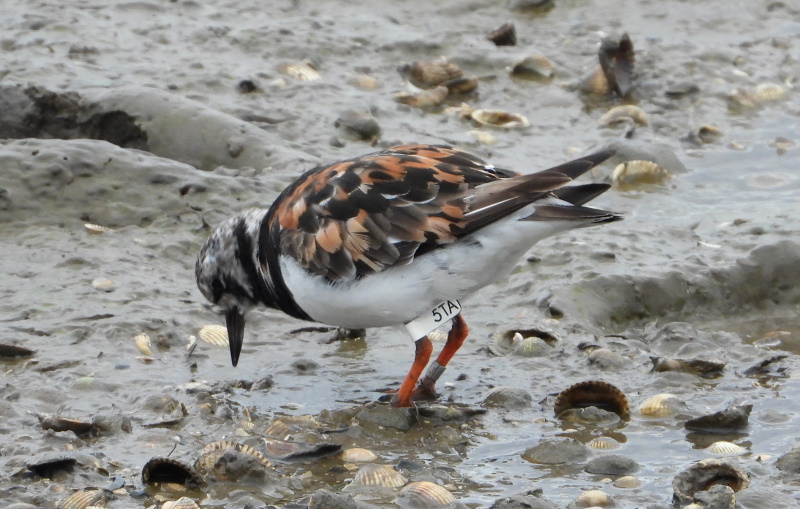
White Flag '5TA'.
Ringed at Alert, Canada, on 31/05/2018.
Recorded at Hilbre on 26/03/2019 and at West Kirby on 19, 22 and
24/08/2022.
Alert is just 500 miles from the North Pole so this is really the far
north of Canada. This bird's arrival at Hilbre in 2019 caused much
excitement and it was a big surprise to see it again this August. When
roosting the white flag was tucked away in the bird's white feathers
making it very difficult to see, so Richard Speechley, the finder, did
very well to spot it.
Oystercatchers
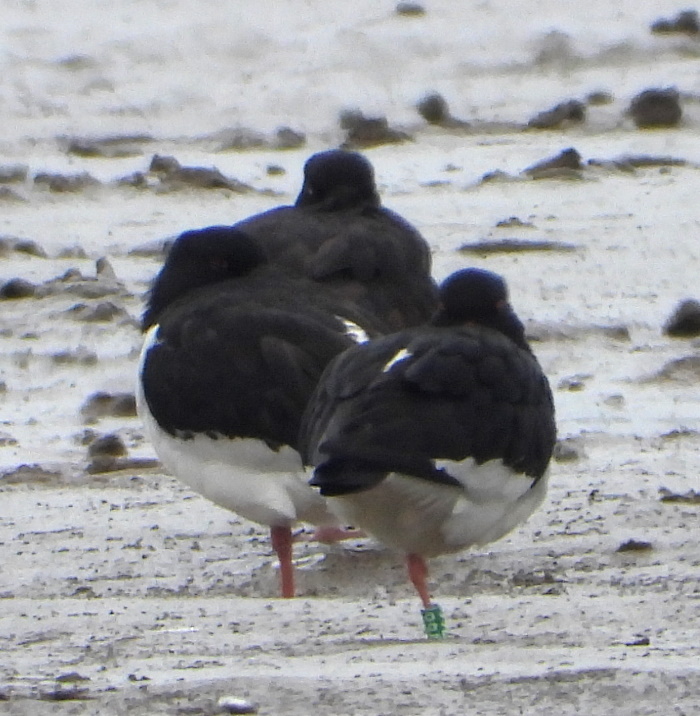
Green T766.
Ringed at Klepp (just south of Stavanger), Norway, on 08/06/2020.
Recorded at Meols on 30/07/2022.
This is just the second Oystercatcher we've recorded which has been ringed in Norway.
White 'L' -
Green/Blue 'Y'
Ringed at Grijpskerke, Netherlands (on coast close to Belgium border)
on 30/06/2013.
Recorded back at the ringing site in March and June 2016, and every
spring since including on 04/03/22.
Recorded on Thurstaston Shore on 02/02/2019, 17/09/2019, 26/11/2020 and
24/07/2022.
So this bird travels north-west from SW Netherlands
to spend the winter on the Dee Estuary. This is very interesting as
according to both the BTO Migration Atlas and the recently published
Eurasian Migration Atlas the vast majority of Dutch breeding
Oystercatchers move south-west for the winter whilst migration to
north-west England is virtually unknown. So it's doing something very
unusual, but it's not the only one as we saw another one in February
2017 which was ringed in NW Netherlands in 2009 and it was back there
in the summer of 2017.
Dunlin
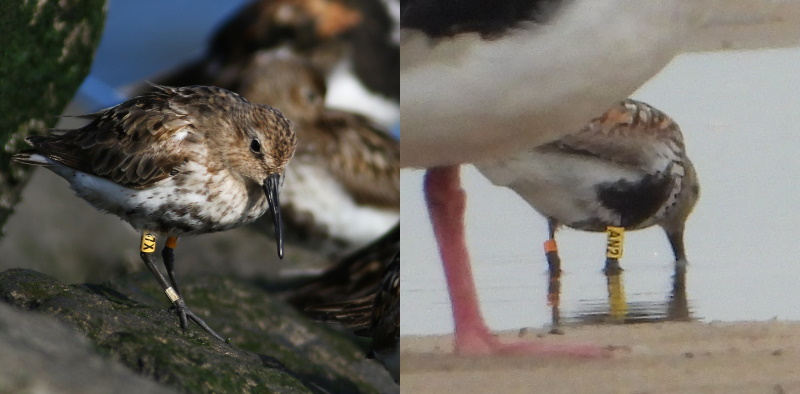
O - Y (47X)
Ringed at Ynyslas (Cardigan Bay) on 11/09/2018.
Recorded at West Kirby on 11/08/2022.
O - Y (AN2)
Ringed at Ynyslas (Cardigan Bay) on 19/08/2020.
Recorded at Meols on 28/07/2022.
These were both ringed by the Mid-Wales Ringing
Group. We've now recorded eight Dunlin ringed at Ynyslas over the past
few years, a number which I thought quite high as the connection
between Cardigan Bay and the Dee Estuary isn't particularly obvious.
But then I read that, since 2016, that they have colour-ringed an
astonishing 6,000+ Dunlin, so now I'm surprised we haven't seen more!
Black-tailed Godwits
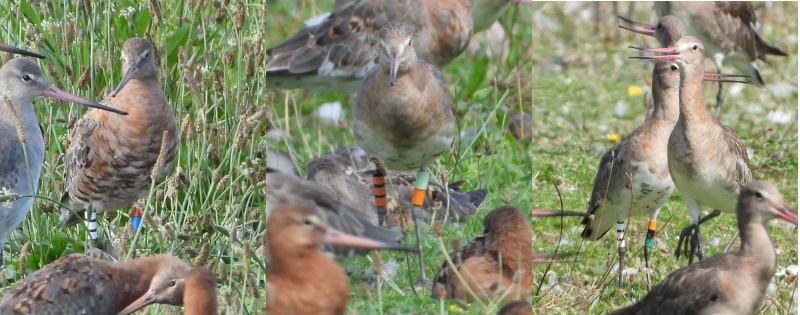
© Richard Smith
RB-W=
Ringed at Lough Beg, Ringaskiddy, Cork Harbour on 01/09/2014.
Recorded both in autumn and early winter at Cork Harbour every year up
to 2021, and also in spring 2018 and 2019.
Also seen in October 2016 at Thameside Nature Park, Thurrock (north
shore of Thames estuary) and at Belfast in August 2019.
Recorded at Caldy Wildfowl Collection in July and August 2022.
LO-O=
Ringed at Belfast Harbour on 21/04/2021.
Recorded at Caldy Wildfowl Collection from the end of August to October
2021.
It was back in Belfast Harbour in March 2022 before returning to Caldy
Wildfowl Collection in August 2022.
ONG-W=
Ringed on Harper's Island, Cork Harbour on 08/09/2020.
Recorded at the ringing site from September 2021 to January 2022.
Recorded at Caldy Wildfowl Collection in August 2022.
Little Egrets
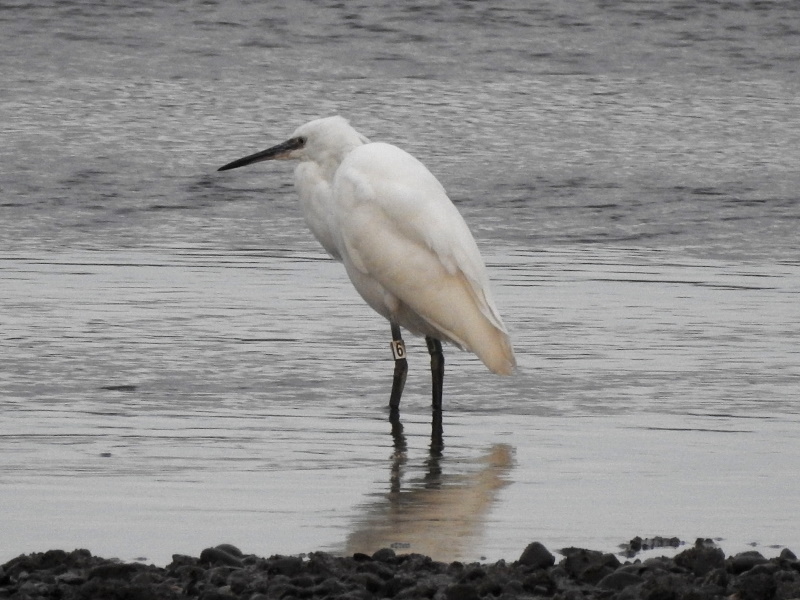
No less than six colour-ringed Little Egrets were
logged in August. No doubt it would have been more if it wasn't for mud
covering the rings!
The Merseyside Ringing Group have been busy ringing Little Egret chicks
at Hale Duck Decoy (north shore of the Mersey Estuary) and with this
new project succeeded in ringing a total of 39 this summer.
Of the four we saw two were from one nest ('White 4 - Green B' and 'White 4 Green D') and the other
two were from another nest ('White 6 -
Green J' and 'White 6 - Green
L').
A third sibling from the second nest was recorded at Audenshaw
Reservoir in July having headed off in the opposite direction from the
other two!
Also recorded were two returning adult birds:
Blue CX
ringed at Newark-on-Trent in May 2017.
Having visited Rutland Water in August 2017 it was seen at Heswall in
September 2019 and every late summer/early autumn since. No winter
records.
Recorded at Thurstaston Shore August 2022.
Blue H4
ringed at Wheldrake Ings, Yorkshire, in July 2019.
Recorded at Heswall in September 2019 and 2020, and November 2021.
It was back breeding at Wheldrake Ings in the summer of 2022 before
being back at Thurstaston August 2022.
Cormorant
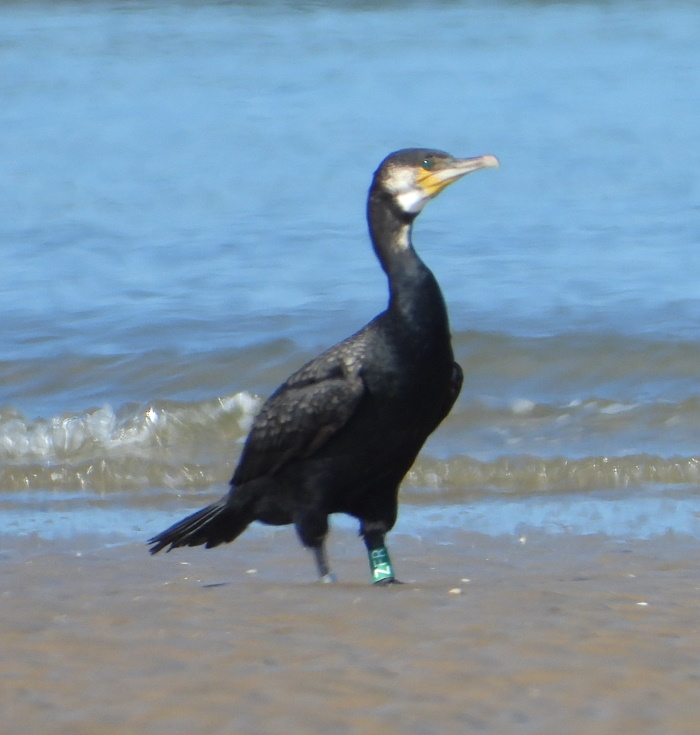
Green - ZFR
Ringed on Puffin Island, Anglesey, on 25/06/2017.
Recorded:
Seaforth August 2017.
Knott End, Lancs, March 2018.
East Hoyle Bank close to Hilbre on 08/08/2022.
Of the twelve Cormorants in our database five have
been ringed on Puffin Island.
Sandwich Terns
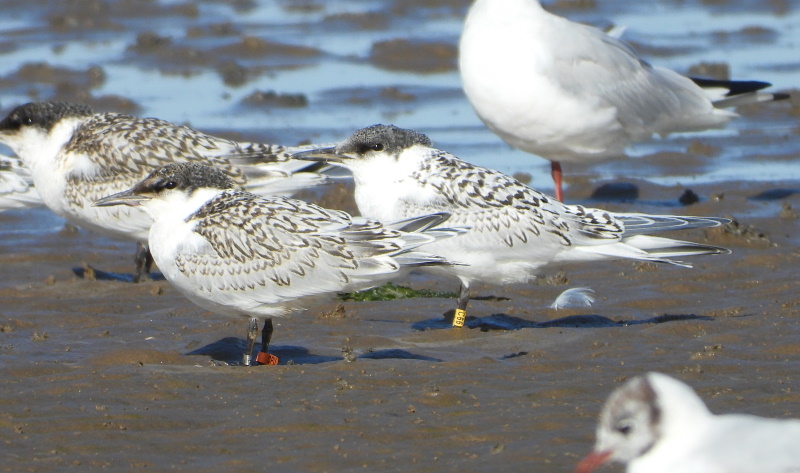
Several more colour-ringed Sandwich Terns were
logged in August, I'm expecting an update on all chicks ringed at
Cemlyn Bay in the next few weeks and a summary of their movements will
be included in the next newsletter. We've recorded 15 of these flagged
Cemyln Bay juveniles here on the Dee Estuary this summer, with many
more records elsewhere in the Liverpool Bay area and further afield.
It's really amazing how much they move around the area after breeding
and before they eventually move south.
Colour Rings were recorded by Richard Smith, Stephen Hinde, Richard Speechley, Alan Hitchmough, Alex Jones, Steve Williams, Elliot Montieth and Derek Bates.
Richard Smith
August Bird News

A juvenile and adult Spotted Crake was seen at
Burton Mere Wetlands throughout the second half of the month,
presumably having bred there. This summer migrant is a rare bird in
this country but as they spend most of the time skulking in reeds no
doubt under recorded. Another one was briefly seen at Parkgate on the
28th, possibly they bred there as well or it may have been just passing
through. The similar looking Water Rail appears to have had a good
breeding season with several reports of juveniles at Parkgate,
including three adults and three young on the 9th at Donkey Stand Flash.
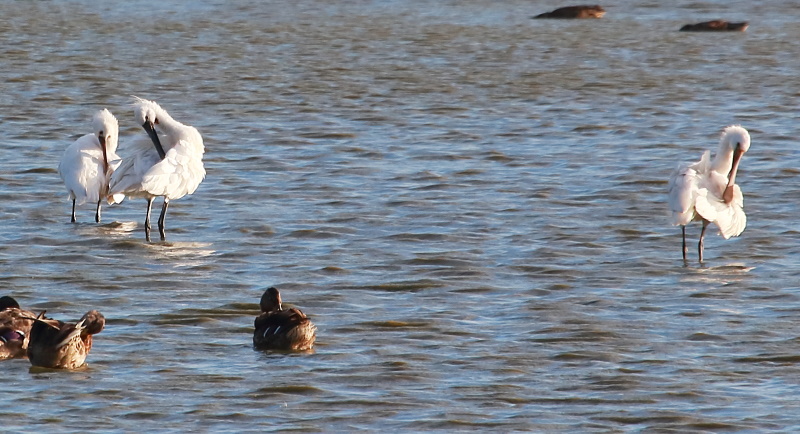
Spoonbills were recorded at Connah's Quay, Parkgate
and Burton Mere Wetlands, and by the end of the month there was a
record equaling 12 at Parkgate - a number last reached in 2016 at
Burton. Up to four Garganey were at Burton Mere Wetlands and probably
bred there. Hobbies were reported at several sites including two seen
regularly hunting over Burton Mere Wetlands.

Greenshanks were passing through all month with
Parkgate having the largest counts with a max of 11. The highest count
of Black-tailed Godwits was of 5,030 at Caldy Wildfowl Collection on
the 17th. 4,400 Redshanks were at Heswall mid-month. On the very last
day of the month the first juvenile Curlew Sandpipers were spotted with
singles at Hoylake and Burton Mere Wetlands, let's hope plenty more
follow.
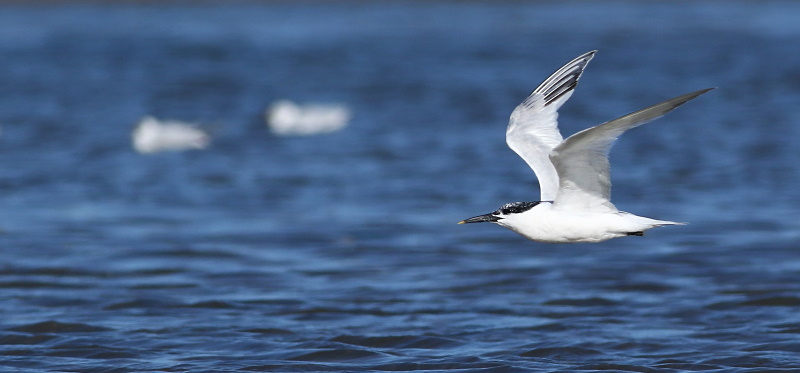
Sea watching was by no means spectacular but an
early morning visit to Hilbre during a fresh westerly on the 7th
produced a respectable count of 125 Manx Shearwaters. The highest count
of Sandwich Terns was also at Hilbre with 750 on the 23rd.
A female/imm Black Redstart visited a garden at
Barnston on the 2nd - a very unusual time of year for this species
here, but we are told several pairs bred around Manchester so maybe we
shouldn't be too surprised. Wheatears were coming through all month
with eight at Meols on the 27th the highest count.
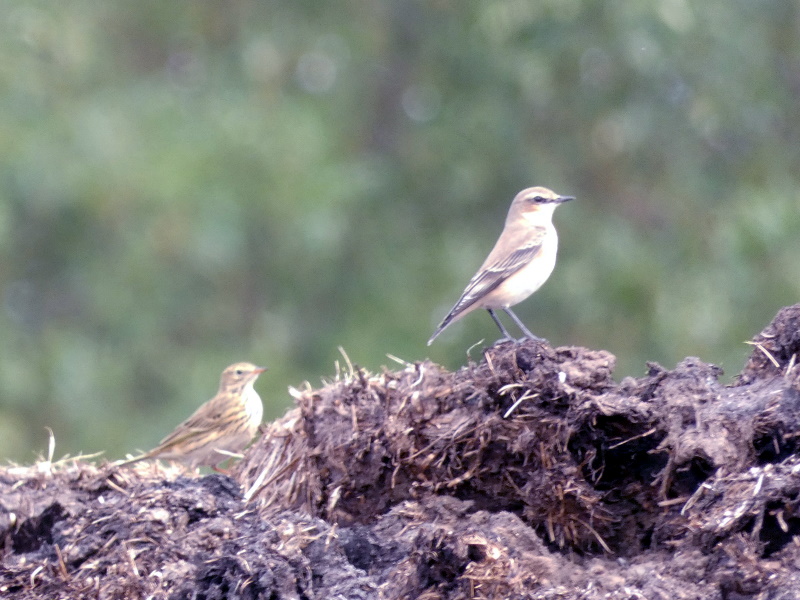
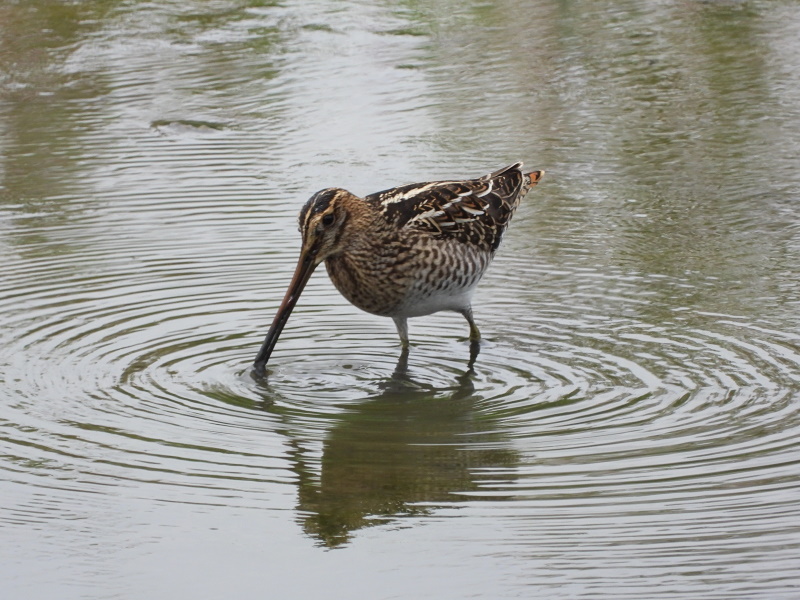
What to expect in September
Given the right conditions our stretch of coastline
will be the best place in Europe to see Leach's Petrels. If we get a
prolonged north-west gale then Leach's Petrels get funneled through the
North-west passage of the Irish Sea with many then blown into the mouth
of the River Mersey before struggling westwards close to the north
Wirral and north Wales coast. The last two Septembers have been
disappointing and we are certainly overdue for a good passage with,
perhaps, several hundred coming though. Gales will also bring in all
four species of Skuas as well as Grey Phalaropes and Sabine's Gulls.
See 'Four
windy days in September' to get an idea of what to expect
(September 2017).
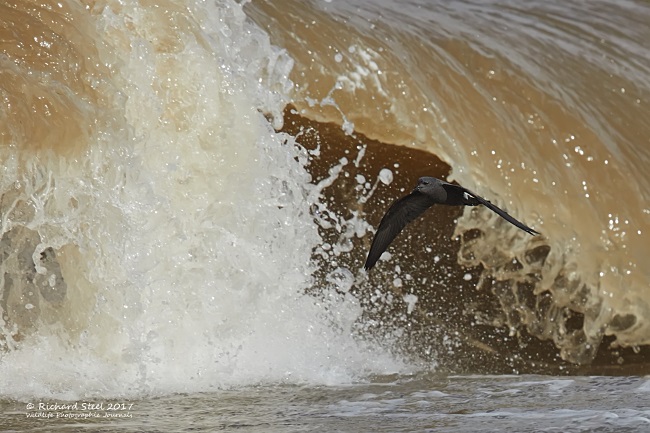
A lack of strong winds would certainly be disappointing but there should still be plenty to see. Juvenile Curlew Sandpipers will be passing through with Hoylake and West Kirby often the best spots early in the month with more at Burton Mere Wetlands later on. Also look out for Little Stints at the same sites. September is always good for Egrets and we could get Cattle Egrets in double figures and at least 40 Great Egrets.
A sign of the coming winter will be return of
Pink-footed Geese with many small skeins arriving and landing on the
marsh.
Forthcoming Events
September Highest Spring Tides (Liverpool)
Also see Tides page.
11th September, 12.39hrs (BST), 9.6m.
12th September, 13.17hrs (BST), 9.5m.
Forthcoming Events
See events at https://events.rspb.org.uk/deeestuary